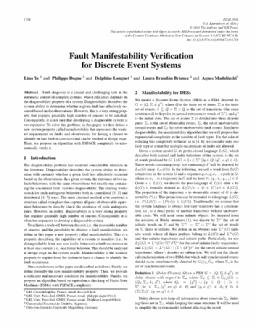| dc.contributor.author | Ye, Lina | |
| dc.contributor.author | Dague, Philippe | |
| dc.contributor.author | Longuet, Delphine | |
| dc.contributor.author | Brandán Briones, Laura | |
| dc.contributor.author | Madalinski, Agnes | |
| dc.date.accessioned | 2023-07-04T14:30:53Z | |
| dc.date.available | 2023-07-04T14:30:53Z | |
| dc.date.issued | 2016 | |
| dc.identifier.uri | http://hdl.handle.net/11086/548025 | |
| dc.description | Ponencia presentada en la 22nd European Conference on Artificial Intelligence ECAI-16. La Haya, Holanda del 29 agosto al 2 de septiembre de 2016. | es |
| dc.description.abstract | Fault diagnosis is a crucial and challenging task in the automatic control of complex systems, whose efficiency depends on the diagnosability property of a system. Diagnosability describes the system ability to determine whether a given fault has effectively occurred based on the observations. However, this is a very strong property that requires generally high number of sensors to be satisfied. Consequently, it is not rare that developing a diagnosable system is too expensive. To solve this problem, in this paper, we first define a new system property called manifestability that represents the weakest requirement on faults and observations for having a chance to identify on line fault occurrences and can be verified at design stage. Then, we propose an algorithm with PSPACE complexity to automatically verify it. | en |
| dc.format.medium | Electrónico y/o Digital | |
| dc.language.iso | eng | es |
| dc.rights | Attribution-NonCommercial 4.0 International | * |
| dc.rights.uri | http://creativecommons.org/licenses/by-nc/4.0/ | * |
| dc.source | e-ISSN: 1879-8314 | |
| dc.subject | Fault diagnosis | en |
| dc.subject | Manifestability | en |
| dc.title | Fault manifestability verification for discrete event systems | en |
| dc.type | conferenceObject | es |
| dc.description.fil | Fil: Ye, Lina. Université Paris-Saclay. CentraleSupélec; France. | fr |
| dc.description.fil | Fil: Ye, Lina. Université Paris-Sud. Laboratoire de Recherche en Informatique; France. | fr |
| dc.description.fil | Fil: Ye, Lina. Centre National de la Recherche Scientifique. Laboratoire de Recherche en Informatique; France. | fr |
| dc.description.fil | Fil: Dague, Philippe. Université Paris-Sud. Laboratoire de Recherche en Informatique; France. | fr |
| dc.description.fil | Fil: Dague, Philippe. Centre National de la Recherche Scientifique. Laboratoire de Recherche en Informatique; France. | fr |
| dc.description.fil | Fil: Longuet, Delphine. Université Paris-Sud. Laboratoire de Recherche en Informatique; France. | fr |
| dc.description.fil | Fil: Longuet, Delphine. Centre National de la Recherche Scientifique. Laboratoire de Recherche en Informatique; France. | fr |
| dc.description.fil | Fil: Brandán Briones, Laura. Universidad Nacional de Córdoba. Facultad de Matemática, Astronomía, Física y Computación; Argentina. | es |
| dc.description.fil | Fil: Madalinski, Agnes. Otto-von-Guericke-University Magdeburg; Germany. | es |
| dc.journal.pagination | 1718-1719 | |
| dc.journal.volume | 285 | |
| dc.description.field | Ciencias de la Computación | |
| dc.conference.city | La Haya | |
| dc.conference.country | Países Bajos | |
| dc.conference.editorial | IOS Press BV | |
| dc.conference.event | 22nd European Conference on Artificial Intelligence ECAI-16 | |
| dc.conference.eventcity | La Haya | |
| dc.conference.eventcountry | Países Bajos | |
| dc.conference.eventdate | 2016-8 | |
| dc.conference.journal | Frontiers in Artificial Intelligence and Applications | |
| dc.conference.publication | Revista | |
| dc.conference.work | Artículo Completo | |
| dc.conference.type | Conferencia | |
| dc.identifier.doi | https://doi.org/10.3233/978-1-61499-672-9-1718 | |
| dc.contributor.orcid | https://orcid.org/0000-0003-1679-0804 | es |
| dc.contributor.orcid | https://orcid.org/0000-0002-8394-276X | es |





